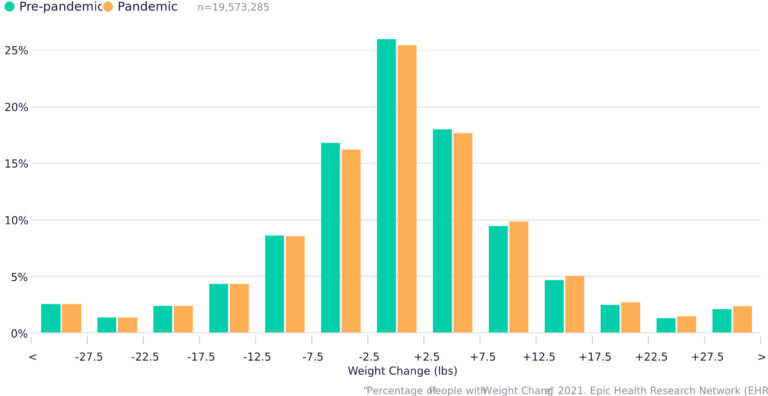When many gym and athletic centers closed in March of 2020 in response to the COVID-19 pandemic, many turned to exercise routines they could complete at home. But others abandoned their exercise schedule altogether.
Even before anyone knew how long the pandemic would last jokes were already circulating about the “COVID 15” (a play on the “freshman 15” that references the weight gain some new college students experience).
Now over 18 months since those gym closures began many have re-opened. Yet some studies have sought to understand what impact this shift in lifestyles has had on Americans’ waistlines.
Early Pandemic Study
Before many of the changes that March 2020 brought, JAMA Network had launched a research study in February that tracked the monthly weight changes of 7,400 middle-aged men and women.
Though the study only tracked 4 months of changes, coming to an end in June 2020, it did report a steady increase of 1.5 pounds each month over the period. This totaled an average weight gain of 6 pounds for the participants between February and June of 2020.
In theory, if this 1.5 pounds per month weight gain continued until the start of this summer in June 2021, may have resulted in a 25 pound weight increase. Fortunately, this weight gain did not continue for the majority of American’s, with some likely even dropping the pounds they briefly gained before 2020 came to a close.
After a Full Year How Much Weight Did We Gain?
Fortunately, year-to-year weight changes are significantly smaller than the JAMA Network revealed on a month-to-month basis early in the pandemic.
Data from 15 million patients compared their pre-pandemic weight to their current weight a year later. In total, 39% of patients gained more than 2.5 pounds during the pandemic. Only weight gain greater than 2.5 pounds is considered significant because even pre-pandemic over 25% of Americans would gain or lose 2.5 pounds every year.
While this rate of weight gain does sound grim, it is still closely in line with the pre-pandemic rate. For each weight category, the percentage of patients actually gaining that weight only increased by about 1% or less. An estimated 5% of patients gained between 12.5 and 17.5 pounds. But prior to the pandemic, about 4.5% of patients would have gained the same weight.

How Did the Pandemic Effect Weight in Children?
When schools closed in 2020, health experts speculated that children may be most vulnerable to weight gain as they would no longer be offered a healthy school lunch each day or the opportunity to go out to an organized recess.
According to a CDC study published in September, childhood obesity has risen from 19% to 22% since the start of the pandemic.
It’s Not Just About Exercise – It’s About Healthy Eating
While much of this article has highlighted gym closures and the emphasis on being home as the driving force behind weight gain, healthy eating is just as important. 2020 was a stressful year, and everyone deals with stress differently. For some patients, stress eating was a vice that was a critical contributor to their weight gain.
Eating at home is often healthier than eating out at fast-food restaurant instead (at least on paper). The problem comes with overeating or having a diet sparse in fruits and vegetables even when at home. Eating a poor diet and being stressed are two of the leading contributors to raising cortisol levels. This can result in a decrease in muscle mass and metabolism function.
Even when eating at home a commitment to a healthy diet is necessary, combined with adequate physical activity to maintain or lose weight.


